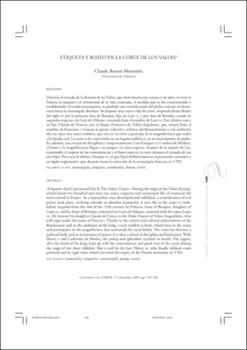Etiqueta y boato en la corte de los Valois
Autor
Benoit Morinière, ClaudeFecha
2009Resumen
During the reign of the Valois dynasty,
which lasted two hundred and sixty-one years, etiquette and ceremonial life of courtesan life
were created in France. As a monarchist state developed and stabilized, a centralization of real
power took place, evolving towards an absolute monarchy. A new life in the court is established, inspired from the end of the 15th century by Princess Anne of Beaujeu, daughter of
Louis XI, and by Anne of Brittany, remarried to Louis of Orleans, crowned with the name Louis
XII. He marries his daughter Claude de France to the Duke Francis of Valois-Angoulême, who
will reign under the name of Francis I. Thanks to the artistic and cultural achievements of the
Renaissance and to the ambition of the king, a new nobility is born, which lives in the court
and participates in the magnificence that surrounds the royal family. The court has become a
political body and an instrument of power. It is also a school of discipline and behaviour. With
Henry II and Catherine de Medici, the pomp and splendour reached its zenith. The regent,
after the death of the king, kept up with the conveniences and good tone in the court during
the reign of her three children. But it will be the last, Henry III, who finally defined court
protocol and its rigid rules, which last until the expiry of the French monarchy in 1789. Durante el reinado de la dinastía de los Valois, que duró doscientos sesenta y un años, se creó en Francia la etiqueta y el ceremonial de la vida cortesana. A medida que se fue construyendo y estabilizando el estado monárquico, se produjo una centralización del poder real que evolucionaría hacia la monarquía absoluta. Se impone una nueva vida de corte, inspirada desde finales del siglo xv por la princesa Ana de Beaujeu, hija de Luis XI, y por Ana de Bretaña, casada en
segundas nupcias con Luis de Orleans, coronado bajo el nombre de Luis XII. Este último casa a su hija Claude de Francia con el duque Francisco de Valois-Angulema, que reinará bajo el nombre de Francisco I. Gracias al aporte cultural y artístico del Renacimiento y a la ambición del rey, nace una nueva nobleza, que vive en la corte y participa de la magnificencia que rodea a la familia real. La corte se ha convertido en un órgano político y en un instrumento de poder.
Es, además, una escuela de disciplina y comportamiento. Con Enrique II y Catalina de Médicis, el boato y la magnificencia llegan a su apogeo. La reina regente, después de la muerte del rey, mantendrá el respeto de las conveniencias y el buen tono en la corte durante el reinado de sus tres hijos. Pero será el último, Enrique III, el que fijará definitivamente el protocolo cortesano y su rígido reglamento, que durarán hasta la extinción de la monarquía francesa en 1789.





